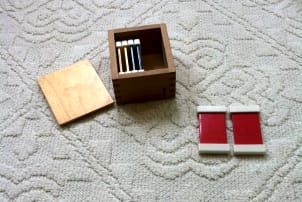The child is introduced to the names of the primary colours: blue, red and yellow.
Color Box #1

Aim
The child’s visual sense of colour develops.
Objectives
- Learn the names of the colours
- Gain experience in matching
- Develop fine motor skills
- Gain indirect preparation for controlling the pencil
Age
2½+
Materials
Box containing 3 pairs of colour tablets
Language
Colors: blue, red, yellow.
Introduce each word only once the child can match the colour.
Control of Error
None
Presentation
Perform this exercise at the table or on a small floor mat (preferably of a pale neutral colour as this helps emphasize the tablets’ colours).
Show the child how to hold the tablets with a tripod grip on the bottom edge. This helps keep the tablets clean and strengthen the fingers for later writing.
Lay the tablets in random order on the table top. Keep them vertical, with the white bars at the top and bottom of the tablets. Pick up a tablet and place it on the mat. Ask the child to find another tablet of the same colour. The two tablets are placed side by side. Continue with placing the next pair of colours underneath the first, until the three pairs of tablets are matched. Mix the tablets again and invite the child to have a turn.
Tips
Extend the child’s learning by offering other objects for sorting activities, such as soft & warm pompoms, wooden beads or silky scarves—pictured here are bells and fabric tiles. The child may use either the fingers, a spoon or tongs.
Further Challenges

Offer the child opportunities to isolate the three primary colours with sorting and matching activities. For example: prepare three coloured bags and fill them with identical objects and materials that differ in colour only. Put them in a large shallow basket and ask the child to fill each coloured bag with the objects of the same colour.
When the child is able to pair the tablets and name the colours effectively, the child is ready for the presentation of the Montessori Colour Box #2.